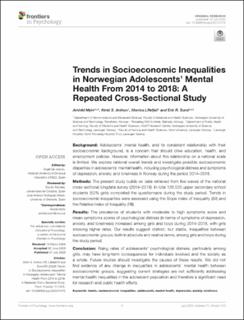Trends in Socioeconomic Inequalities in Norwegian Adolescents' Mental Health from 2014 to 2018 : A Repeated Cross-Sectional Study.
Peer reviewed, Journal article
Published version

Åpne
Permanent lenke
https://hdl.handle.net/11250/2728684Utgivelsesdato
2020Metadata
Vis full innførselSamlinger
Originalversjon
Myhr, A., Anthun, K. S., Lillefjell, M. & Sund, E. R. (2020). Trends in Socioeconomic Inequalities in Norwegian Adolescents’ Mental Health From 2014 to 2018: A Repeated Cross-Sectional Study. Frontiers in Psychology, 11: 1472. doi: 10.3389/fpsyg.2020.01472Sammendrag
Background: Adolescents’ mental health, and its consistent relationship with their socioeconomic background, is a concern that should drive education, health, and employment policies. However, information about this relationship on a national scale is limited. We explore national overall trends and investigate possible socioeconomic disparities in adolescents’ mental health, including psychological distress and symptoms of depression, anxiety, and loneliness in Norway during the period 2014–2018. Methods: The present study builds on data retrieved from five waves of the national cross-sectional Ungdata survey (2014–2018). In total 136,525 upper secondary school students (52% girls) completed the questionnaire during the study period. Trends in socioeconomic inequalities were assessed using the Slope Index of Inequality (SII) and the Relative Index of Inequality (RII). Results: The prevalence of students with moderate to high symptoms score and mean symptoms scores of psychological distress (in terms of symptoms of depression, anxiety, and loneliness) increased among girls and boys during 2014–2018, with girls showing higher rates. Our results suggest distinct, but stable, inequalities between socioeconomic groups, both in absolute and relative terms, among girls and boys during the study period. Conclusion: Rising rates of adolescents’ psychological distress, particularly among girls, may have long-term consequences for individuals involved and the society as a whole. Future studies should investigate the causes of these results. We did not find evidence of any change in inequalities in adolescents’ mental health between socioeconomic groups, suggesting current strategies are not sufficiently addressing mental health inequalities in the adolescent population and therefore a significant need for research and public health efforts.
